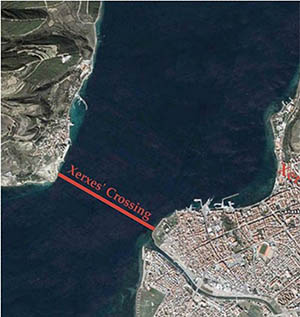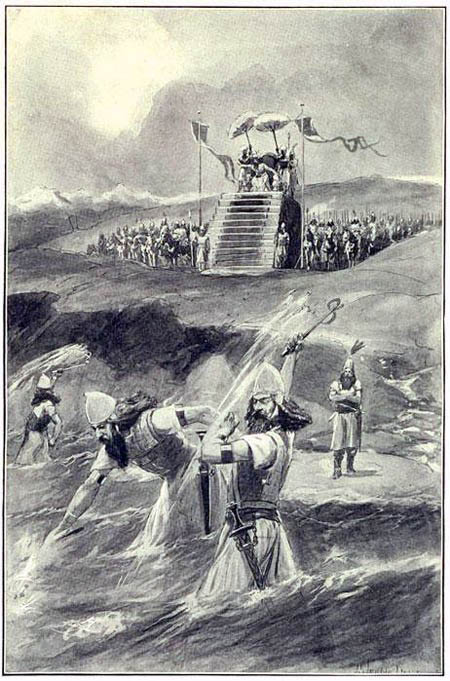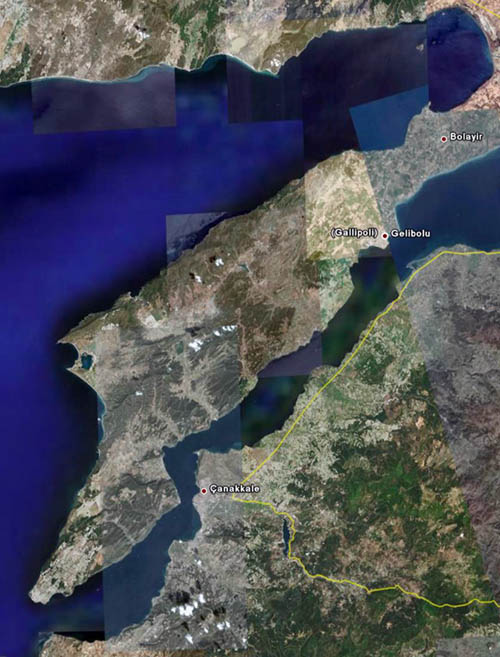Xerxes and the Hellespont
Today, we visit an ancient bridge over troubled waters. The University of Houston presents this series about the machines that make our civilization run, and the people whose ingenuity created them.
It's the rare bridge that goes nowhere. Most go somewhere -- occasionally, they even span worlds. So it seemed in 480 BC when the Persians, under Xerxes, invaded Greece.
The Hellespont, now known as the Dardanelles, is a narrow body of water, only a mile across at certain points. But it was a formidable geographical and symbolic barrier between Asia and Europe. When Xerxes' engineers bridged it, the consequences were seismic.
In Herodotus's history of the Persian Wars, Xerxes' forces are a juggernaut, flattening everything in their path westward. The army was so vast, Herodotus declares, that it dried the rivers where it stopped to water its horses.
Modern historians now agree that Herodotus dramatically inflated the size of the Persian force: He claimed two million soldiers. More likely, no more than two hundred thousand soldiers formed its ranks. Nevertheless, Xerxes' army dwarfed the small, divided and panicking Greek city-states.
 More credible is Herodotus' description of the Hellespont bridges. The engineers first threw parallel structures across the straits, one using flax cables, the other papyrus cables connected to windlasses on the shore. But a storm then shattered the bridges. Xerxes' anger was directed not just at the engineers -- who literally lost their heads -- but also at the Hellespont. The waters were whipped 300 times and shackles dropped into them as a mark of enslavement.
More credible is Herodotus' description of the Hellespont bridges. The engineers first threw parallel structures across the straits, one using flax cables, the other papyrus cables connected to windlasses on the shore. But a storm then shattered the bridges. Xerxes' anger was directed not just at the engineers -- who literally lost their heads -- but also at the Hellespont. The waters were whipped 300 times and shackles dropped into them as a mark of enslavement.
With a new batch of engineers more determined than their unhappy predecessors, the bridges were rebuilt. This time each was girded by a combination of flax and papyrus cables. Beaded along the two sets of cables were more than 600 side-by-side triremes serving as pontoons. The triremes, in turn, were, anchored a both ends and spaced far enough part to allow other ships to pass between. Laid from one side of the tethered ships to the other was a roadway, fenced and covered with grass and earth so that "the beasts of burden ... would not look out to the sea below and panic."
Herodotus then leads us to a second kind of bridge: one between meanings. For the ancient Greeks, the word barbarian at first was descriptive: It meant someone who didn't speak Greek, but, instead, garbled incomprehensibly: bar-bar-bar. Herodotus often admires the non-Greeks and marvels at their achievements. But he calls Xerxes a barbarian when he punishes the waters. This act of hubris -- of overweening pride -- reflects the shift to the second meaning: a barbarian is someone who violates the norms of reason and measure.
Herodotus already understood, over two millennia ago, a lesson we struggle with in modern times: that technology, neutral in itself, provides tools. Xerxes' men could build a great bridge. But Xerxes forgot what it was to be a man. Technology can all too easily be abused by barbarians of any tongue or of any age.
I'm Rob Zaretsky, at the University of Houston, where we're interested in the way inventive minds work.
The Landmark Herodotus: The Histories. Tr. by Andrea Purvis, introduced by Rosalind Thomas, edited by Robert Strassler (New York: Pantheon 2007)
The Herodotus history of Xerxes at the Hellespont may be read online here: http://www.eagleacademy.org/herodotus.htm
Thanks to Jim Bell, KUHF-FM, for suggesting the topic, to Google Earth for the aerial photos of the Dardanelles, and Wikipedia for the public domain image of Xerxes lashing the sea.

